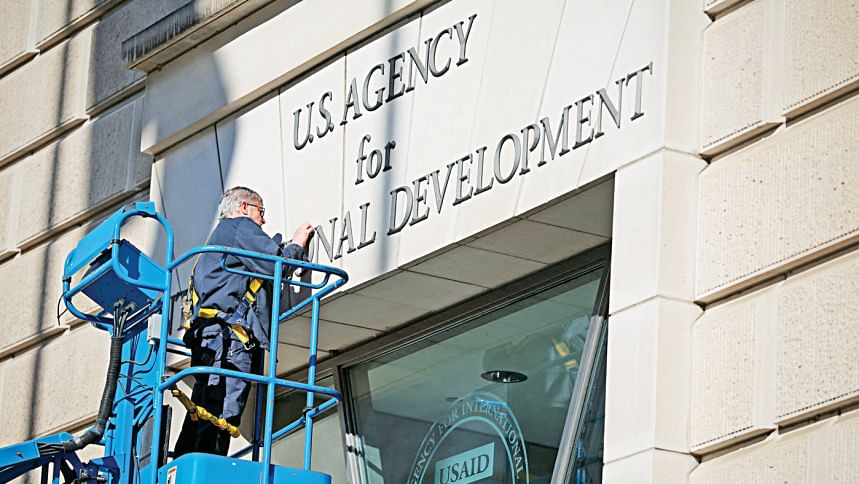Development aid’s future is hiding in plain sight

Donald Trump's new administration has plunged international development assistance into an existential crisis. Within hours of taking office in January, the president had issued, an executive order mandating a 90-day pause on most aid to poorer countries. Last week, the State Department confirmed it was cutting more than 90 percent of the US Agency for International Development's programmes.
The radical overhaul is upending other countries' development assistance too. Prime Minister Keir Starmer last month announced he was slashing Britain's aid budget from 0.5 percent to 0.3 percent of GDP to help meet US demands for increased defence spending. The previous government had already reduced aid from 0.7 percent of GDP. Britain's minister for international development promptly resigned. Yet the travails of the traditional model of development assistance started well before the latest assault. Four longer-term trends were already challenging its basic assumptions.
The first is the globalisation of international capital markets over the past several decades. In the 1960s and 1970s developing countries seeking external finance had to rely on governments or multilateral institutions. Over the last decade, however, more than 90 percent of capital flows to low and middle-income countries came from private investors.
That change was due in large part to a second long-term trend: the economic transformation of the countries known collectively as the "Global South." In 1990, developing nations accounted for barely more than a third of global GDP. Today, their share is about 60 percent. What is more, many of those countries are exporting capital, including the biggest of them all – China.
A third trend challenging the traditional model of international development aid was its ever more expansive objectives. Until the end of the 1980s, development essentially meant economic growth. In 1990, the United Nations introduced the Human Development Index, which emphasised health and education as well. Climate and gender equality were added to the mix in the 2000s. By the time UN member countries unanimously adopted the 2030 Agenda for Sustainable Development, in 2015, it included no fewer than 17 Sustainable Development Goals, measured by 169 separate targets.
More comprehensive notions of what development is led to less consensus on how to promote it – the fourth long-run trend. In the 1960s and 1970s, development economists saw the problem as plugging gaps in domestic savings or the supply of foreign exchange.
In the following two decades the focus shifted to making aid conditional on market-liberalising policy reforms. By the new millennium, confidence in that model of assistance also began to crumble. The fact that China – and indeed much of East Asia – had eschewed the so-called "Washington Consensus" of free trade and financial liberalisation was simply too big to ignore.
All four of these long-term trends were driven by the geopolitical shifts. The early model of official capital flows aimed simply at turbo-charging growth rested on the geostrategic rivalry of the Cold War. The concept of aid unlocking private finance in pursuit of broad social and environmental objectives, meanwhile, relied on the rules-based, international order that flourished after 1989.
Trump's return to the White House means the geopolitical tectonic plates are shifting once again. The challenge for those who believe in the basic ethical principle of assisting poorer countries is to find a model of development assistance which also serves donors' strategic interests in a more contested and multipolar world.
One candidate is the model adopted by China over the past decade. Since 2013, the People's Republic has provided at least $1.3 trillion in development finance under its Belt and Road Initiative (BRI) – becoming by some distance the largest single bilateral donor in the world. The BRI's focus on borrowers sympathetic to China's broader geostrategic goals supports the policy's realist credentials. Yet economically, its success is questionable. The research organisation Aiddata.org estimates that 80 percent of lending by the People's Republic is now supporting borrowers in financial distress. It concludes that the lending spree has landed Beijing in "an unfamiliar and undesirable role – as the world's largest official debt collector." That is hardly a model most donors would wish to imitate even if they could.
Another possibility is that the United States reallocates its aid budget to the State Department rather than abolishing it altogether. Yet it is not obvious how international development assistance could coherently serve an explicitly isolationist US foreign policy: the intrinsic tensions would be just too great.
The most successful model of how to marry idealism with strategic utility in development assistance is hiding in plain sight. It is the process of accession to the European Union which in a single generation has enabled eleven economically underdeveloped and institutionally enfeebled countries in eastern Europe to join the ranks of the most prosperous nations on earth.
It is tempting to think the EU's circumstances are so specific that there can be nothing for other donors to learn. Yet the financial sums involved were not especially large. The real secret sauce was explicit political partnership, the coherence of aid and trade, and the resulting extreme openness of recipient countries to private capital inflows. These core elements of the recipe are transferable. Even better, they really work.
In 1993, the EU's current Eastern members had an average per capita GDP barely one tenth of its Western old guard. All were classified as developing countries. Three decades later, Poland is richer than Portugal, Slovenians are better off than Spaniards, and every country, is a member of the elite high-income nations club. Just as notable as the economic impact of the EU's enlargement has been its geostrategic success. Two blocs which were on opposite sides of a nuclear stand-off for forty-five years – and fought centuries of wars before that – are now as tightly allied as any on earth.
If that is not a model of international development assistance fit for a hard-nosed, realist age, it is difficult to know what is.

 For all latest news, follow The Daily Star's Google News channel.
For all latest news, follow The Daily Star's Google News channel. 



Comments